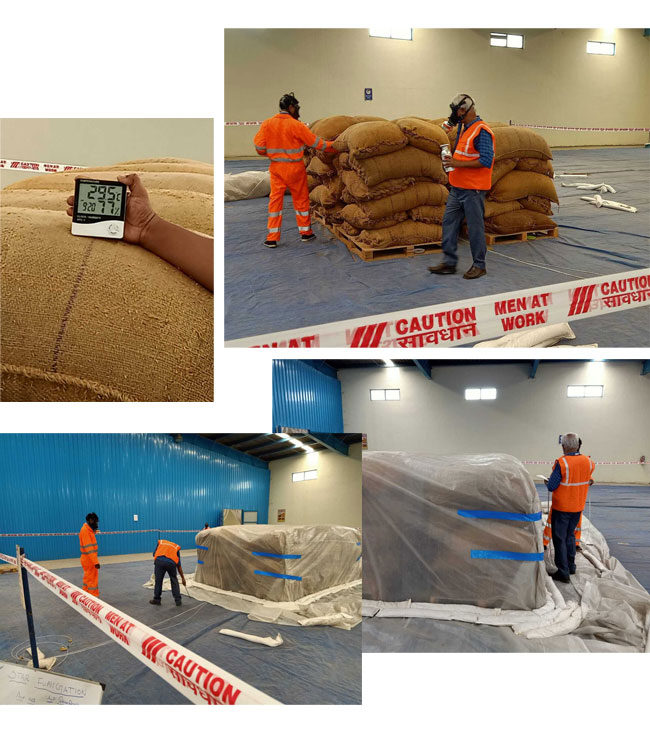Storage Fumigation
Storage fumigation is the process of using fumigants (chemical gases or vapors) to eliminate pests from stored goods, warehouses, or storage facilities. This method is commonly used in industries where products are stored for long periods, such as food storage, grain silos, warehouses, and even in logistics for containerized goods. The aim is to eradicate pests that could infest the stored items, ensuring the goods remain in good condition and free of contamination.

Key Aspects of Storage Fumigation:
1. Purpose of Storage Fumigation
- Pest Control: It is used to eliminate insects, rodents, and other pests that may infest food products, grains, textiles, and other stored goods.
- Prevent Damage: Pests like weevils, beetles, or moths can damage stored products, especially food and agricultural products, making them unfit for consumption or sale.
- Hygiene and Safety: Fumigation helps maintain sanitary conditions in storage facilities, reducing the risk of contamination.
2. Types of Pests Treated
- Insects: Common pests include grain weevils, rice moths, and other storage insects that infest grains, dried fruits, or packaged food.
- Rodents: Mice and rats that can infest storage areas, contaminating food products.
- Mites and Fungi: Fumigation can also help control pests like mold or mildew that grow in humid storage environments.
- Other pests: In some cases, stored textiles and other products may also need fumigation to control pests like carpet beetles or fabric moths.
3. Fumigants Used in Storage Fumigation
- Phosphine Gas: One of the most common fumigants used in storage fumigation, especially for grains, dried fruits, and food products. It is released in gas form and works by disrupting the pests' respiratory system.
- Sulfuryl Fluoride: Often used for fumigating items like stored grain, wood products, and some packaged goods.
- Methyl Bromide: Though phased out due to its environmental impact, it is still used in some cases for fumigating stored goods, particularly in cases involving international shipments.
- Carbon Dioxide (CO2): Sometimes used in combination with other methods for less toxic fumigation, especially in food storage.
- Inspection: A thorough inspection of the storage area is performed to determine the presence of pests and assess the severity of the infestation.
- Sealing: The storage area or containers are sealed to contain the fumigant and prevent it from escaping, ensuring the fumigant can effectively reach all areas and penetrate the goods.
- Fumigation Application: Fumigants are introduced into the sealed area. The type of fumigant and the method of application (gas, solid pellets, or tablets) will depend on the storage facility and the types of pests being treated.
- Exposure Time: The fumigant needs time to work, typically ranging from 24 to 72 hours, depending on the type of fumigant and the pests being treated.
- Ventilation: After the fumigation process is complete, the area must be ventilated to clear the air of any remaining fumigants, ensuring that it is safe for humans and animals to re-enter.
- Follow-Up Inspection: After fumigation, a follow-up inspection may be carried out to verify the effectiveness of the treatment and ensure no pests remain.
- Effective Pest Control: Fumigation is often the most efficient and thorough method for eradicating pests from large areas or bulk storage, ensuring that every inch of the space and goods is treated.
- Prevention of Infestation: By treating the goods before they enter storage, fumigation prevents the spread of pests, which could otherwise infest the facility and spread to other areas.
- Long-Term Results: Unlike surface treatments (e.g., sprays), fumigation can penetrate deep into stored goods, ensuring that pests hidden within the products are eliminated. Compliance: Fumigation ensures that goods are compliant with local and international regulations, especially for exports, where pest-free products are often required.
- Toxicity of Fumigants: Fumigants can be highly toxic to humans, animals, and plants. It is important that fumigation be done by licensed professionals who are trained to handle chemicals safely.
- Evacuation: The storage area must be evacuated during fumigation, and no one should be allowed to enter until the fumigant has dissipated and it is safe.
- Proper Ventilation: Once fumigation is complete, proper ventilation is required to ensure that no toxic gases remain in the area. Regulatory Compliance: Fumigation procedures must adhere to local and international laws to ensure safety and effectiveness. This includes the correct documentation of fumigation certificates for export goods.
- Infestation of Stored Goods: If pests are detected in bulk storage, warehouses, or containers, fumigation is an effective way to eradicate them.
- Before Export: Many countries require fumigation of stored products, especially agricultural products, to ensure that they are free of pests before shipment.
- Preventive Treatment: Even if no pests are detected, fumigation may be used as a preventive measure to avoid potential infestations, particularly in high-risk areas.
